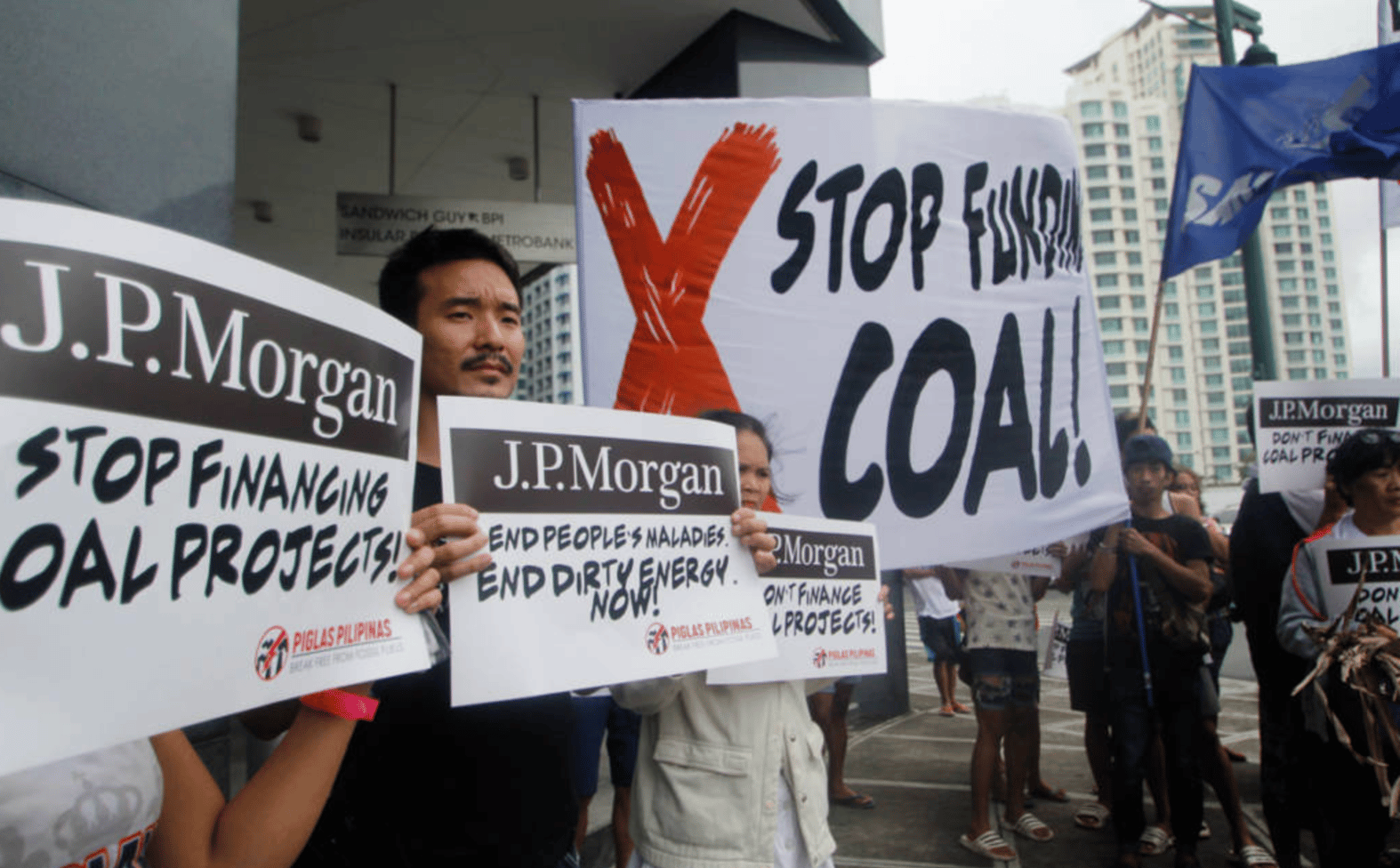
Climate justice activists protest in front of the JPMorgan office in Bonifacio Global City, in the Philippines, in October 2017, to call for the multinational bank to stop funding coal and fossil fuels. Courtesy 350 Philippines
Under Trump's second administration, there's no longer any need for banks to pretend to be anti-fossil fuels and so, like oil majors, one by one the world's largest financial institutions have been walking back their climate commitments. Vanguard was the first to ditch the Net Zero Banking Alliance, bowing out in late 2022. JP Morgan, the world’s largest financier of fossil fuels, dropped out early this year, followed by BlackRock. All three caved to pressure campaigns and legal threats from a broad "anti-ESG" movement threatening everything from kicking the banks out of particular states to filing anti-trust lawsuits against them. Though the suits, which made vague allusions to "collusion" amongst banks against the fossil fuel industry, were deemed meritless by most legal analysts, the threat was enough to send banks fleeing from climate commitments they'd only made a few years prior.
"When institutions backtrack on such significant pledges, it raises questions about their sincerity in future climate-related commitments and erodes public trust in financial institutions as anchors in the shift towards a more sustainable, low-carbon economy," Mark Kalegha, Energy Finance Analyst at the Institute for Energy Economics and Financial Analysis (IEEFA) said. "Stepping away from pledges made just a few years ago sends the wrong message to the global community and stakeholders that climate action can be optional when it’s inconvenient or challenging."
But unlike U.S. government agencies, banks can't just scrub their websites entirely of any mention of climate. As not just American but global entities, banks don't want to lose business from clients who are increasingly aware of and concerned about the financial risks associated with climate disasters. So, while major financial institutions have abandoned voluntary climate commitments, we are increasingly seeing them replace the rhetoric of “emission reduction” with something far more profitable: climate risk management.
This approach, while certainly not new, shifts the focus away from addressing climate change from a financial standpoint or making financial flows consistent with lowering greenhouse gas emissions. It's a brilliant rhetorical shift that allows banks to continue gaslighting at an industrial scale while cloaking themselves in the language of climate responsibility.
Morgan Stanley’s March 2025 climate forecast predicting 3 degrees of warming, which it described as a boon to the air conditioning industry, and JPMorgan’s Climate Intuition, a so-called “thought leadership series” launched in February 2025, are amongst the latest attempts to rebrand Wall Street as the best-equipped to “navigate” the economic consequences of environmental catastrophes that it is also funding. Boston Consulting Group, BNP Paribas and Standard Chartered are all also using the language of resilience and risk pricing to reframe their involvement in the climate crisis. According to a JPMorgan statement provided to Drilled, although its Global Head of Sustainability did not respond to our request for comment by the time of publication, the series "meets the demand of its clients for dedicated climate science capabilities and solutions, helping them realize business opportunities while navigating the challenges of a changing climate."
In the first installment, author Sarah Kapnick, JPMorgan’s Global Head of Climate Advisory and former NOAA Chief Scientist, spent 10 pages acknowledging climate change’s realities—financial disruptions, and the increasing likelihood of extreme weather events. But she stopped short of asking the real question: how far should we expect financial institutions to go to protect their clients' bottom lines? And how can we trust their advice on mitigating risk when they're financing projects that actively increase that risk at the same time?
This first report, which the bank states was not reviewed, endorsed or otherwise approved by, and is not a work product of any research department of JPMorganChase & Co. and/or its affiliates, although it was published as a JPMorgan report, asks people to believe financial institutions are on the cutting edge of climate risk management. And while it highlights that “continuing with static thinking based on experience alone will make it difficult to identify emerging climate risks and accurately price them in” the implicit message here is that disaster uncertainty can be conquered through better financial modeling—not through a fundamental shift in the way banks continue, increasingly so, to fund fossil fuel projects globally. The new approach is simple: if extreme weather events are inevitable, why not profit from the fallout? It's disaster capitalism at its finest.
Kapnick also skillfully downplays the urgency of climate change throughout the report. Rather than calling for systemic change, Climate Intuition frames climate catastrophe as something investors must adapt to—another variable to be priced into financial models. Even its language is carefully crafted to obscure responsibility, referring vaguely to emissions caused by “human activities” rather than explicitly acknowledging the role of fossil fuels. As Dan Cohn, Energy Finance Analyst at IEEFA, points out, "Words matter when it comes to climate risk, but deeds matter more. The most meaningful measure will be banks’ patterns of lending and underwriting as the world continues to warm."
Kapnick does not mention fossil fuels, even though the overwhelming majority of greenhouse gas emissions come from burning coal, oil and gas. She does not acknowledge either how the bank's financing decisions contribute to rising emissions — with $434 billion provided to oil, gas, and coal companies (more than any other financial institution) between 2016 and 2022.
Toward the end of the report, JPMorgan invokes carbon dioxide removal (CDR) technologies and "overshoot" scenarios as part of a broader climate risk strategy.
These concepts are not new. Overshoot scenarios are based on the idea that the world may exceed the 1.5°C warming threshold temporarily before reversing course through emissions reductions and large-scale carbon removal. The Intergovernmental Panel on Climate Change (IPCC) has modeled overshoot pathways, some of which assume that CDR technologies—such as direct air capture or large-scale reforestation—can remove enough carbon from the atmosphere to bring temperatures back down after an initial breach of 1.5°C or even 2°C. However, these assumptions rest on highly uncertain scientific foundations. Even if the technologies do work as promised, the IPCC has warned that a significant amount of irreparable harm will occur as the world warms past 1.5°C. There is no going back, as appealing as the idea is to policymakers, techno-optimists and, apparently, banks.
No existing CDR technology is currently capable of removing carbon from the atmosphere at the scale required to correct a substantial overshoot. Direct air capture (DAC) remains incredibly expensive—requiring enormous energy inputs to “extract” CO₂ from ambient air— and has been linked to air pollution. Large-scale afforestation projects, often presented as nature-based solutions, come with serious ecological and land-use conflicts—including the displacement of communities. Even projections from the IPCC and the International Energy Agency (IEA) acknowledge that CDR, which the JPMorgan report positions as a requirement, cannot substitute for immediate, deep cuts to emissions.
Corporations are happy to talk about climate resilience—strengthening infrastructure, reinforcing supply chains, hedging against extreme weather. But without cutting emissions, resilience is just a buzzword, a way to delay the inevitable while pretending to prepare for it. You can build seawalls, retrofit buildings, and rewrite insurance policies all you want, but there is no version of the future, not even for Wall Street, in which we can endlessly adapt to climate disasters while emissions keep rising. "For years, banks’ discourse on climate outpaced their actions, with the same institutions that promised net-zero readiness continuing to pour money into fossil fuel expansion," Connor Chung, Energy Finance Analyst at IEEFA, pointed out. He warns that financial risks in the coming decades are not set in stone: "The nature of the climate-related financial risks that investors face in the coming years and decades are neither inevitable nor fully predetermined. The future will hinge in large part on the decisions of significant actors such as financial institutions."
Climate change threatens fundamental market stability, yet banks continue to treat it as just another risk to be managed—until, of course, it won’t be.
